4-H Poultry Judging
Each 4-H Poultry Judging Contest has four classes on consumer information, the grading of exterior eggshell factors, broken-out eggs, and ready-to-cook poultry. The highest total score for the contest is 500 points. The four classes are:
- Class 1 – Ready-to-Cook Poultry. You will grade five ready-to-cook broilers according to USDA standards and record the grade for each bird on the scorecard. You will list the reasons for grading each carcass immediately after each grade. Each reason must include the type of factor or defect, the size or degree of the defect, and the location of the defect on the broiler. List all reasons as they appear in the Standards for Ready-to-Cook Poultry chart.
Example: If a cut less than 1½ inches in size is observed on the breast, the carcass will be classified as a B quality carcass followed by the reason: “cut on breast less than 1½ inches.”
Contestants should not touch the carcasses. Touching could change carcass grades during the contest. You can easily see downgrading factors without handling the broilers. You are not allowed to use charts, manuals, or other instructional materials in the contest. Total Point Value – 200 points (100 on your grading of the broilers and 100 on your reasons for grading).
- Class 2 – Classifying Broken-Out Eggs. You will grade 10 broken-out eggs as AA, A, or B quality according to the USDA Egg Grading Standards. Each egg is displayed in a transparent container with a transparent cover. Touching the egg or container is not permitted because it could change the grade of the egg. Record the grade for each egg in the proper space on the score card. Total Point Value – 100 points.
- Class 3 – Classifying Shell Factors. You will classify 10 shell eggs by shell factors. You will make two decisions on each egg. You will decide on the cleanliness of each egg and record it as Clean, B Stain, or Dirty. Then, you will determine the soundness and shape of each egg and list it as Practically Normal or Abnormal. Each egg will be displayed with a transparent cover. Touching the egg or container is not permitted. Total Point Value – 100 points.
- Class 4 – Consumer Test. Each contestant will be given a written test with no more than 20 questions on eggs and ready-to-cook poultry. Questions will be true-false, multiple choice, or fill in the blank. You can find the answers to all of the questions in this manual.
Senior division contestants are responsible for all information in this manual. Junior division contestants will be asked questions from information in the Things the Consumer Needs to Know about Eggs and Ready-To-Cook Poultry section. Total Point Value – 100 points.
Class 1 – Grading Ready-to-Cook Poultry
The difference between standards of quality and grades is sometimes misunderstood. Standards of quality specify various factors that determine the grade. These factors, such as fat covering, fleshing, exposed flesh, discolorations, and others, determine the grade of the birds when evaluated collectively. The U.S. Consumer Grades for Poultry are the most important because they are the grades that retailers use. The U.S. Consumer Grades are U.S. Grade A, U.S. Grade B, and U.S. Grade C.
Most ready-to-cook birds are graded in processing plants after evisceration. Ready-to-cook poultry must be inspected for wholesomeness in accordance with USDA regulations before it can be officially graded. Only a few birds are graded at points other than processing plants, and these birds must be in a form that makes it possible to examine the entire carcass.
Ready-to-cook poultry, poultry products, or parts that are unsound or unwholesome are not eligible for grading. Decomposition (slimy or slippery skin condition, putrid or sour odor) exclude ready-to-cook products from a grade. The sale of unwholesome poultry meat products for human consumption is not permitted.
Determining Quality
Consider the following factors in determining the quality of an individual ready-to-cook carcass or part:
- Conformation
- Fleshing
- Fat
- Freedom from pinfeathers
- Freedom from exposed flesh resulting from cuts, tears, and broken bones
- Freedom from discoloration of skin and from flesh blemishes and bruises
The tolerances for certain dressing defects vary with the weight of a ready-to-cook carcass and whether they are on the breast and legs or elsewhere on the carcass.
After determining the class and condition, you should evaluate each quality factor. You will base the final quality rating of the bird on the factor with the lowest rating. For example, if a bird meets the requirements for A Quality in all factors except one which is B Quality, the final grade would be B Quality.
In grading ready-to-cook poultry, you should evaluate the intensity, size, and location of the defects for proper quality determination. Defects considered most important are bruises, exposed flesh and cuts, missing parts, and broken or disjointed bones.
Standards for Ready-to-Cook Poultry
A Quality
- Conformation – The carcass is free of deformities that detract from its appearance or that affect the normal distribution of flesh. Slight deformities such as slightly curved or dented breastbones and slightly curved backs may be present.
- Fleshing – The carcass has a well-developed covering of flesh.
- The breast has sufficient flesh to give it a rounded appearance with the flesh carrying well up to the crest of the breastbone along its entire length.
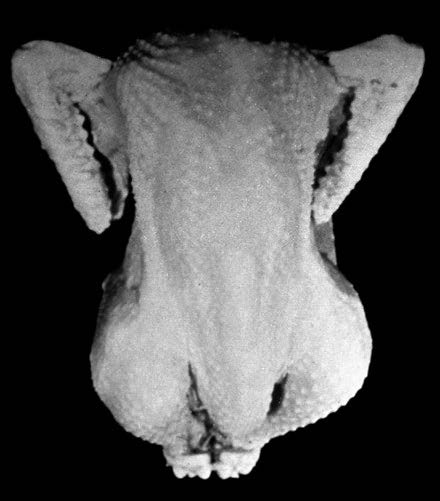
Grade A - The leg is well-fleshed and moderately thick and wide at the knee and hip joint area and has a well-rounded, plump appearance with the flesh carrying well down toward the hock and upward to the hip joint area.
- The drumstick is well-fleshed and moderately thick and wide at the knee joint and has a plump, rounded appearance with the flesh carrying well down toward the hock.
- The thigh is well to moderately fleshed.
- The wing is well to moderately fleshed and has a well-developed layer of fat in the skin. The fat is well-distributed so there is a noticeable amount of fat in the skin in the areas between the heavy feather tracts.
- Defeathering – The carcass has a clean appearance, especially on the breast. The carcass is free of pinfeathers (a feather not fully developed) and visible hair.
- Exposed Flesh – The carcass is free of exposed flesh resulting from cuts, tears, and missing skin (other than slight trimming on the edge) on the breast and legs. Elsewhere, the carcass may have exposed flesh due to slight cuts, tears, and areas of missing skin providing the combination of the areas of exposed flesh does not exceed the area as specified in the standards of quality for ready-to-cook poultry chart.
- Disjointed and Broken Bones and Missing Parts – The carcass is free of broken bones and has no more than one disjointed bone. The wing tips may be removed at the joint. The tail may be removed at the base.
- Discolorations of the Skin and Flesh – The carcass is practically free of such defects. Discoloration due to bruising should be free of clots (discernible clumps of red or dark cells). Evidence of incomplete bleeding, such as more than an occasional slightly reddened feather follicle, is not permitted. Flesh bruises and discolorations of the skin such as “blue back” are not permitted on the breast or legs of the carcass. The total area of all discolorations for a carcass must not exceed the area as specified in Table 1.
B Quality
- Conformation – The carcass can have moderate deformities that do not substantially affect the distribution of flesh or the appearance of the carcass. Deformities can be a dented, curved, or crooked breast. Deformities can also be a crooked back or misshapen legs or wings.
- Fleshing – The carcass has a moderate covering of flesh.
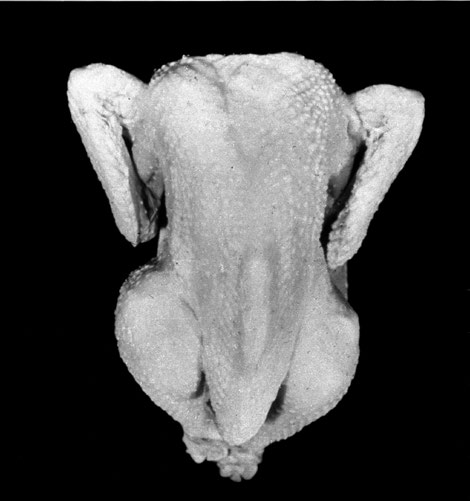
Grade B - The breast substantially covers the flesh and sufficiently carries up to the crest of the breastbone to prevent a thin appearance.
- The leg is fairly thick and wide at the knee and hip joint area, and it has sufficient flesh to prevent a thin appearance.
- The drumstick has a sufficient amount of flesh to prevent a thin appearance.
- Fat Covering – The carcass has sufficient fat that prevents a distinct appearance of the flesh through the skin, especially on the breast and legs.
- Exposed Flesh – The carcass may have exposed flesh resulting from cuts, tears, and missing skin, provided that the combination of the areas of exposed flesh does not exceed the area as specified in Table 1.
- Disjointed and Broken Bones and Missing Parts – The carcass may have two disjointed bones or one disjointed bone and one non-protruding-broken bone. Parts of the wing beyond the second joint may be removed at a joint. The tail may be removed at the base.
- Discolorations of the Skin and Flesh – The carcass is free of serious defects. Discoloration due to bruising should be free of clots (visible clumps of red or dark cells). Evidence of incomplete bleeding should be very slight. Moderate areas of discoloration due to bruises in the skin or flesh and moderately shaded discoloration of the skin such as “blue back” are permitted. The total area of all discolorations for a carcass must not exceed the area as specified in Table 1.
C Quality
A carcass that does not meet the requirements for A or B Quality can be C Quality. Both wings may be removed or neatly trimmed. Trimming of the breast and legs is permitted, but not to the extent that the normal meat yield is materially affected. The back may be trimmed in an area not wider than the base of the tail and extending from the tail to the area between the hip joints.
Table 1. Standards of quality for ready-to-cook poultry. (Minimum requirements and maximum permitted defects.)
A Quality
- Conformation: Normal
- Backbone: Slight curve or dent
- Back: Normal (except slight curve)
- Legs and Wings: Normal
- Fleshing: Well-fleshed, moderately long, deep and rounded breast
- Fat: Covering Well-covered — especially between heavy feather tracts on breasts
- Pine Feathers
- Non-protruding pins and hair
- Breast and legs: Practically free
- Elsewhere: Practically free
- Protruding pins
- Breast and legs: Free
- Elsewhere: Free
- Non-protruding pins and hair
- Cuts, tears, and missing skin
- Breast and legs: Free
- Elsewhere: 1½“
- Disjoined bones
- Breast and legs: 1
- Elsewhere: 1
- Broken Bones: None
- Missing Parts: Wing tips and tail
- Discolorations
- Flesh bruises
- Breast and legs: 0”
- Elsewhere: ½”
- Skin bruises
- Breast and legs: ¼“
- Elsewhere: 1”
- All discolorations
- Breast and legs: 1”
- Elsewhere: 2”
- Flesh bruises
B Quality
- Conformation: Moderate deformities
- Backbone: Moderately dented, curved, or crooked
- Back: Moderately crooked
- Legs and Wings: Moderately misshapen
- Fleshing: Moderately-fleshed
- Fat: Covering Sufficient fat on breast and legs to prevent distinct appearance of flesh through the skin
- Pine Feathers
- Non-protruding pins and hair
- Breast and legs: Few scattered
- Elsewhere: Few scattered
- Protruding pins
- Breast and legs: Free
- Elsewhere: Free
- Non-protruding pins and hair
- Cuts, tears, and missing skin
- Breast and legs: 11/2”
- Elsewhere: 3”
- Disjoined bones: 1 or 2 if no broken bones
- Broken Bones: 1, non-protruding
- Missing Parts: Wing tips, 2nd wing joint, and tail
- Discolorations
- Flesh bruises
- Breast and legs: 1/2”
- Elsewhere: 2”
- Skin bruises
- Breast and legs: 1”
- Elsewhere: 2”
- All discolorations
- Breast and legs: 2”
- Elsewhere: 3”
- Flesh bruises
C Quality
- Conformation: Abnormal
- Backbone: Seriously curved or crooked
- Back: Seriously crooked
- Legs and Wings: Misshapen
- Fleshing: Poorly-fleshed
- Fat Covering: Lacking in fat covering over all parts of carcass
- Pine Feathers
- Non-protruding pins and hair
- Breast and legs: Scattering
- Elsewhere: Scattering
- Protruding pins
- Breast and legs: Free
- Elsewhere: Free
- Non-protruding pins and hair
- Cuts, tears, and missing skin: No limit
- Disjoined bones: No limit
- Broken Bones: No limit
- Missing Parts: Wing tips, wings, and tail
- Discolorations: No limit unless such areas render any part of the carcass unfit for food
Structure and Composition of the Egg
The yolk consists of the lateral, germinal disc, concentric rings of yolk material, and the vitelline membrane (a colorless membrane) that surrounds and contains the yolk. The yolk constitutes approximately 31 percent of the total weight of the egg. The white consists of several layers of albumen that together constitute about 58 percent of the weight of the egg. The chalaziferous layer surrounds the yolk and is continuous with the chalazae. This is a very firm but very thin layer of albumen. It makes up 3 percent of the total albumen.
The inner thin layer surrounds the chalaziferous layer and comprises about 21 percent of the white. The firm and thick layer of albumen provides an envelope or jacket that holds the inner thin white and the yolk. It adheres to the shell membrane at each end of the egg. Approximately 55 percent of the white is firm albumen. The outer thin layer lies just inside the shell membranes except where the thick white is attached to the shell, and accounts for about 21 percent of the total albumen.
The shell membranes are tough and fibrous and are composed chiefly of protein, similar to hair and feathers. The inner membrane is thinner than the outer, and they are only about 24 ten-thousandths of an inch thick. The shell constitutes approximately 11 percent of the egg and is composed of about 94 percent calcium carbonate. Pigment, if any, is laid down in the spongy layer of the shell and is derived from the blood.
Egg Abnormalities
Double-yolked eggs are a result of two yolks being released about the same time. It can also occur when one yolk is lost in the body cavity for a day and is picked up when the next day’s yolk is released by the funnel.
Yolkless eggs are usually formed around tissue that is sloughed off the ovary or oviduct. This tissue stimulates the secreting glands of the oviduct and a yolkless egg results. An egg within an egg is due to reversal of direction of the egg by the wall of the oviduct. One day’s egg is added to the next day’s egg, and a shell is formed around both.
Bloodspots are caused by a rupture of one or more small blood vessels in the yolk follicle at the time of ovulation. Meat spots have been demonstrated to be either blood spots that have changed in color due to chemical action, or tissue sloughed off from the reproductive organs of the hen. Off-colored yolks are due to substances in feed that cause the off-color. Off-flavored eggs may be due to certain feed flavors.
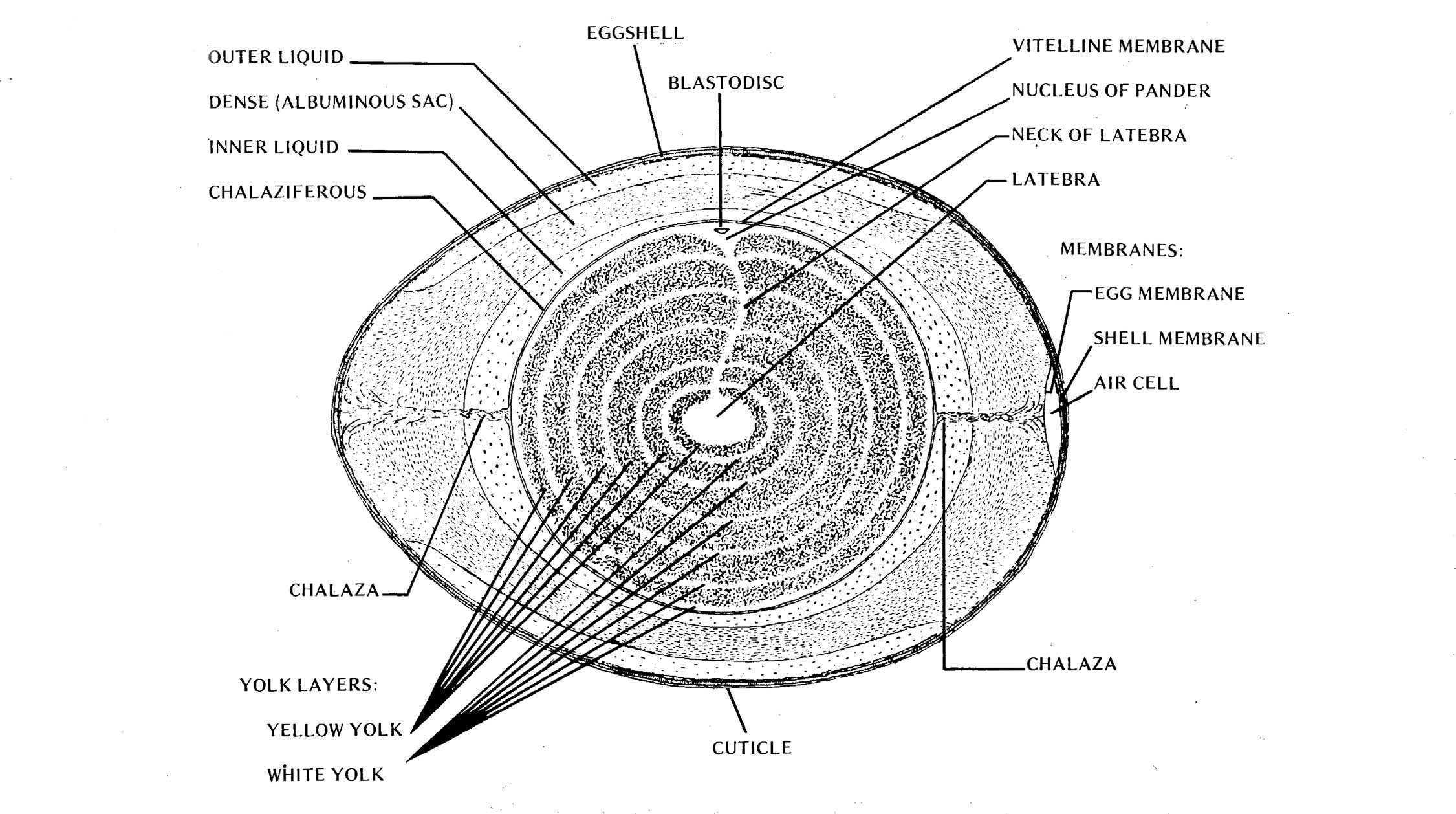
Soft-shelled eggs generally occur when an egg is prematurely laid, and insufficient time in the uterus prevents the shell to deposit. Thin-shelled eggs can be caused by dietary deficiencies or diseases, but they can also be hereditary. Glassy- and chalky-shelled eggs are caused by malfunctions in the uterus of the laying bird. Glassy eggs are less porous and will not hatch, but they can retain their quality.
Egg Grades and Quality
Grading generally involves sorting products according to quality, size, weight, and other factors that determine its relative value. The grading of shell eggs is classifying an individual egg according to established standards. United States Standards for Quality of Individual Shell Eggs are based on interior quality factors such as the condition of the white and yolk, size of the air cell, and they are based on exterior quality factors such as cleanliness and soundness of the shell. These standards cover the entire range of edible eggs.
Eggs are also classified according to weight (or size) stated in ounces per dozen. Although eggs are not sold according to exact weight, they are grouped within relatively narrow weight ranges or weight classes, with the minimum weight per unit specified in Table 3. Egg grading, then, is the grouping of eggs into lots that have similar characteristics of quality and weight.
Although color is not a factor in the U.S. standards and grades, eggs are usually sorted for color and sold as either “whites” or “browns.” Eggs that are sorted according to color and packed separately sell better than eggs sold as “mixed colors.”
Quality may be defined as the essential properties of a product that determine its degree of excellence. Those conditions and characteristics that consumers want and are willing to pay for are factors of quality. The quality of an egg can be determined by comparing a number of factors. One factor alone may determine the quality score of the egg because the final quality score can be no higher than the lowest score given to any one of the quality factors. Quality factors may be divided into two general groups: exterior quality factors which are apparent from external observation and interior quality factors which involve the contents of the eggs.
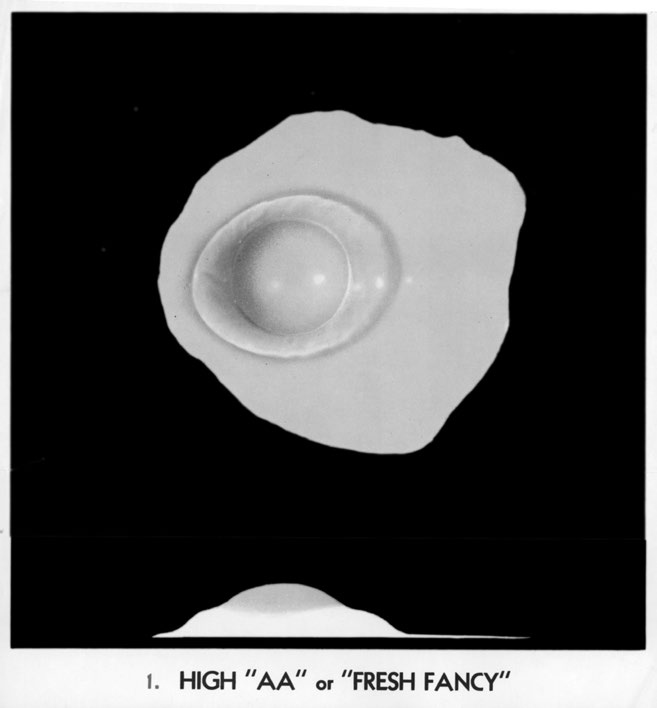
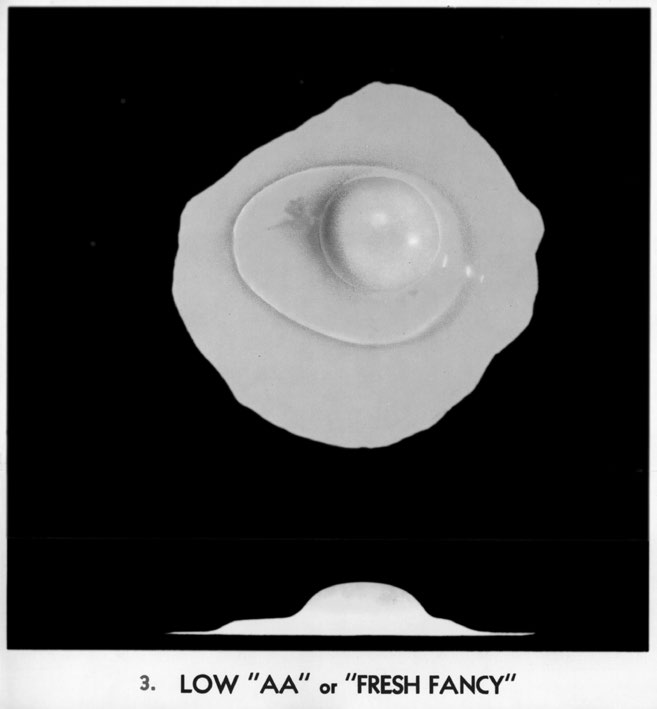
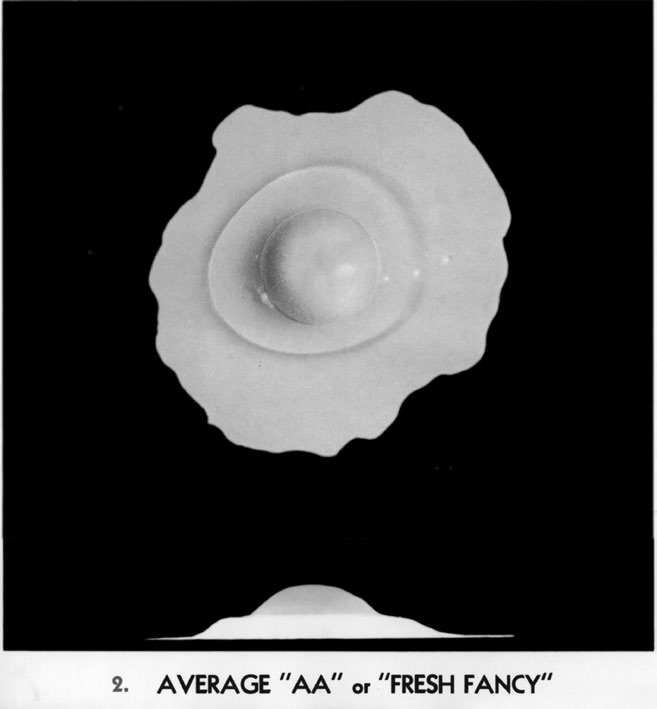
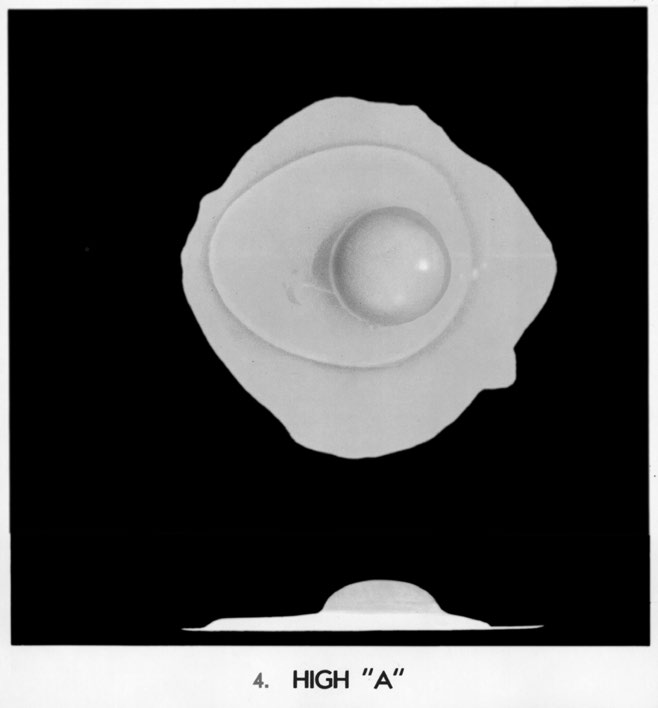
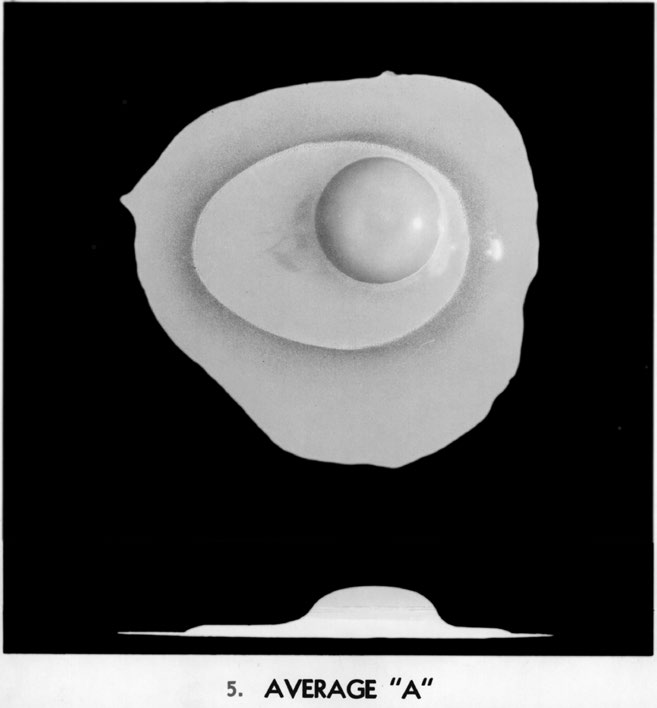
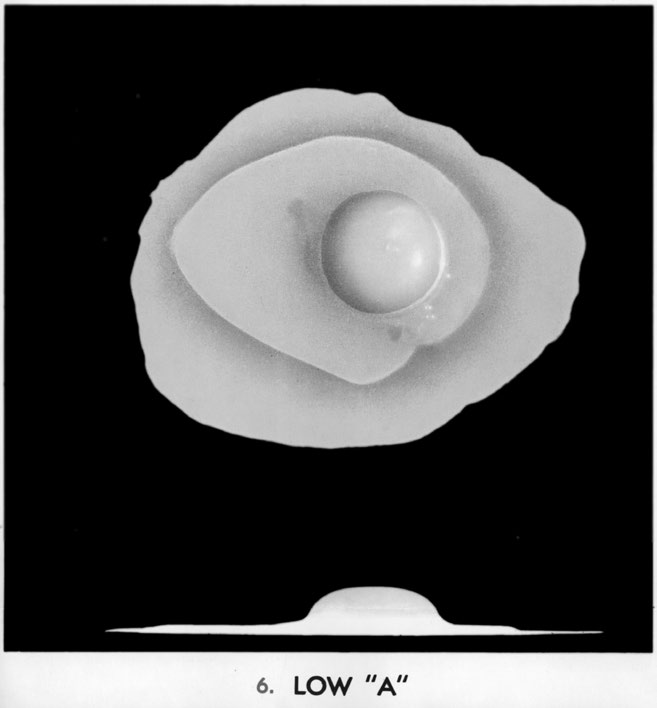
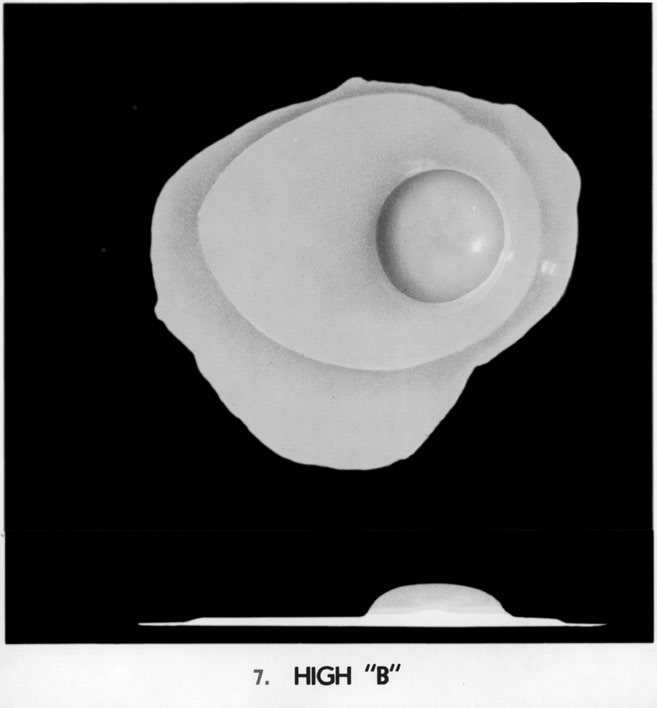
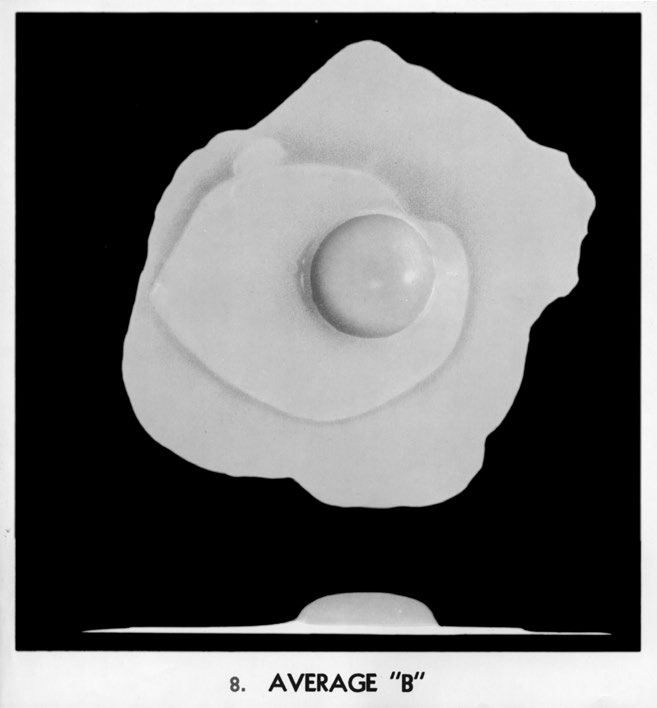
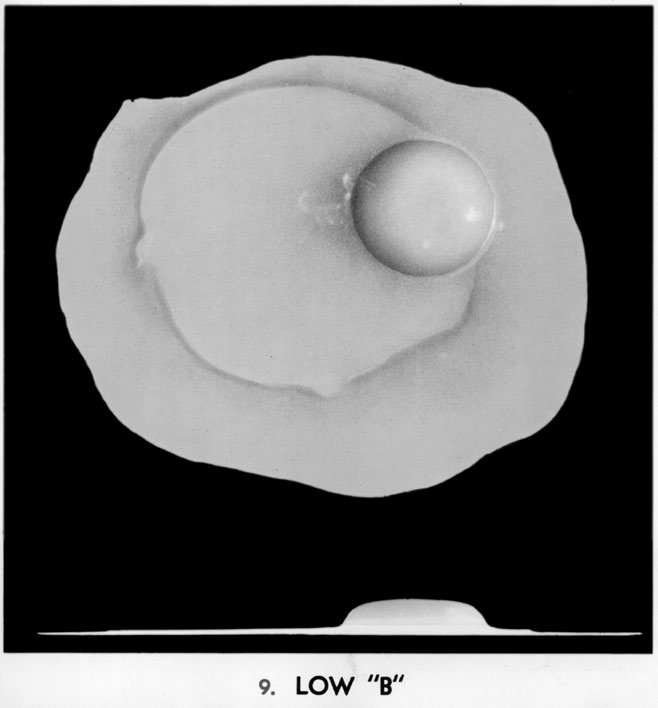
Class 2 – Grading Broken-Out Eggs
The yolk in a new-laid egg is round and firm. As the yolk ages, it absorbs water from the albumen, which increases its size and causes it to stretch and weaken the vitelline membrane and to assume a somewhat flattened shape on top and an “out of round” shape, generally resembling a balloon partially filled with water.
The terms used in the U.S. standards of quality for shell eggs to describe yolk size and shape are:
- Round and upstanding – The ideally shaped yolk is perfectly round and covers a small area. The top of the yolk should be round and upstanding (AA or A Quality).
- Slightly enlarged and slightly flattened – A yolk where membranes and tissues have weakened somewhat, causing it to appear slightly enlarged and slightly flattened (B Quality).
Relatively little is known about the exact causes of most yolk defects other than those due to germ development. Some of the causes may be irregular deposits of light and dark yolk, blemishes from rubbing, and development of accumulations or clusters of the fat and oil in droplets. Unless yolk defects are very prominent, detection of them is difficult, especially when the egg has thick albumen.
The terms used to describe yolk defects are:
- Practically free from defects – A yolk that shows no germ development but may show other very slight defects on its surface (AA and A Quality).
- Other serious defects – A yolk that shows well-developed spots or areas and other serious defects such as an olive yolk that do not render the egg inedible (B Quality).
- Clearly visible germ development – Development of the germ spot on the yolk of a fertile egg that has progressed to the point where it is plainly visible as a circular area or spot with no blood in evidence (B Quality).
- Blood due to germ development – Blood caused by development of the germ in a fertile egg to a point where it is visible as definite lines or as a blood ring. Such an egg is classified as inedible.
Practically all new-laid eggs contain four layers of albumen – Chalaziferous, inner thin, thick, and outer thin. The appearance of the egg is influenced mostly by the relative proportions of the thick and outer thin layers of albumen. The white and yolk are very closely associated and any discussion of either factor involves the other. Two important considerations about the white are included in standards of quality: condition (or viscosity) and clarity.
The following terms describe the white:
- Firm – Albumen covers a very small area and its outer edge is rather uniform. The thick white is compact, rounded on top, and retains the general shape of the unbroken egg. The thick white constitutes most of the albumen content. A very small amount of thin white is present in high-quality eggs (AA Quality).
- Reasonably firm – Albumen is somewhat less thick or viscous than a firm white. The egg covers a moderate area, and the shape of the thick white resembles the shape of an unbroken egg. A considerable amount of thick white is present with a small amount of thin white (A Quality).
- Slightly weak – Albumen that is lacking thickness or viscosity. The egg covers a wide area. A small amount of thick white and much thin white may be observed. The shape of the thick white may or may not resemble the shape of an unbroken egg (B Quality).
- Clear – White that is free from discolorations or from any foreign bodies floating in it. Prominent chalazas should not be confused with foreign bodies such as spots or blood clots (A and AA Quality).
- Blood clots and spots (not due to germ development) – Blood clots or spots commonly called meat spots may be found on the surface of the yolk or floating in the white. If they are small (totaling not more than 1/8 inch in diameter) the egg may be classed as B Quality. If larger, or showing diffusion of blood in the white surrounding them, the egg is classified as loss.
- Bloody white – An egg that has blood diffused through the white. Such a condition may be present in new-laid eggs. Eggs with blood whites are classed as loss.
Class 3 – Classifying Eggs by Shell Factors
The external factors of the egg, such as, color of the shell, shape, and cleanliness, can be determined without using the candling light, but soundness of shell should be verified by candling.
Shell Shape and Texture

AA or A quality.

ridges and rough shell; permitted in
B quality.
A normal egg has an oval shape with one end (air cell end) larger than the other. It tapers toward the smaller end. Measurements of both strength and appearance of many eggs by investigators resulted in the development of the “ideal” egg shape. The shape of an egg can be considerably different from the ideal but may still be considered practically normal. The grader must keep in mind a mental picture of the normal or usual shape of an egg and compare each egg with that picture.
Eggs that are unusual in shape, such as those having ridges or thin spots, are placed in the lower grades. Shells of eggs with thin areas and some other types of shell defects are usually weaker than normal shells, and the danger of breakage en route to the consumer lowers the utility value of the egg. Eggs of abnormal shape also lack consumer appeal, so they are excluded from the top grades. Abnormal shells may result from improper nutrition, disease, or the physical condition of the hen. Sometimes a shell is cracked while the egg is still in the body of the hen. These eggs, which are commonly referred to as “body checks,” are repaired by an additional deposit of shell over the cracked area, generally resulting in a ridged area.
The specifications of the U.S. standards provide three degrees of variation:
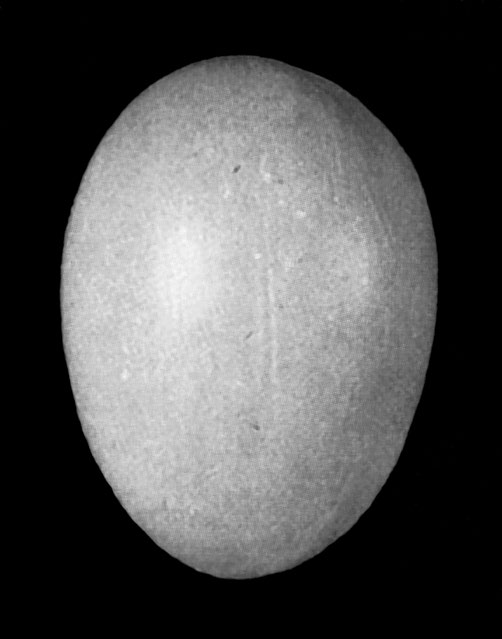
found in AA or A quality.
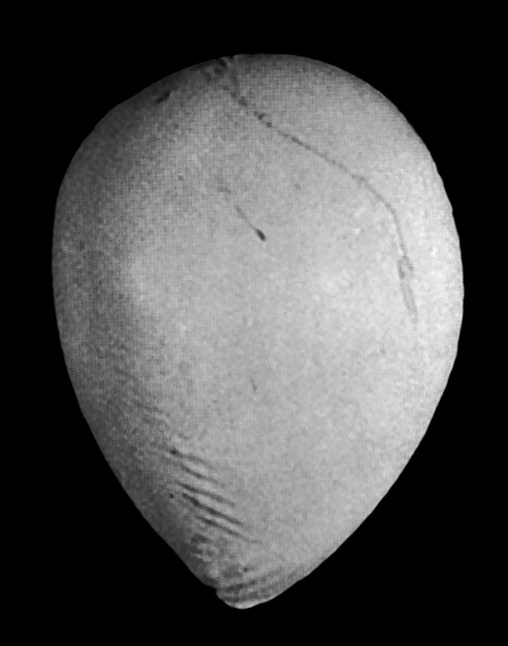
ridges; permitted in B quality.
- Practically normal – A shell that is near the usual shape, is sound, and is free from thin spots. Ridges that do not materially affect the shape and strength of the shell are permitted (A and AA Quality).
- Abnormal – A shell that may be somewhat unusual, very misshapen, faulty in soundness and strength, or may show pronounced ridges or thin spots (B Quality).
- Soundness of shell – The shell of an egg may be sound, checked or cracked, leaking, or smashed.
Following are definitions of these shell factors:
- Sound – An egg whose shell is unbroken.
- Check – An individual egg that has a broken shell or crack in the shell but with its shell membranes intact and its contents not leaking.
- Leaker – An individual egg that has a crack or break in the shell and shell membranes to the extent that the egg contents are exuding or free to exude through the shell.
- Smashed – An egg with a crushed or shattered shell.
Smashed eggs with their contents leaking and leakers are considered as loss in the USDA regulations. Checks may range from a very fine, hair-like check (blind check) that is discernible only before the candling light, to plainly visible dented checks. Blind checks are the most common and frequently the most difficult to detect in rapid candling. Such eggs will not keep well or stand even moderately rough handling, so they should be used immediately.
Cleanliness
Freedom from stains and foreign material on the shell of eggs must be considered in assigning a quality designation to an individual egg. The following terms are descriptive of shell cleanliness:
- Clean – A shell that is free from foreign material and from visible stains or discolorations. An egg may be considered clean if it has only very small specks or stains, or if such specks or stains are not of sufficient number or intensity to detract from the generally clean appearance of the egg. Eggs that show traces of processing oil on the shell are considered clean unless otherwise soiled (A and AA Quality).
- Slightly stained – A shell that is free from adhering dirt, but that has slight stains that do not appreciably detract from the appearance of the egg. When the stain is localized, approximately 1/32 of the shell surface may be slightly stained, and when the slightly stained areas are scattered, approximately 1/16 of the shell surface may be slightly stained (B Quality).
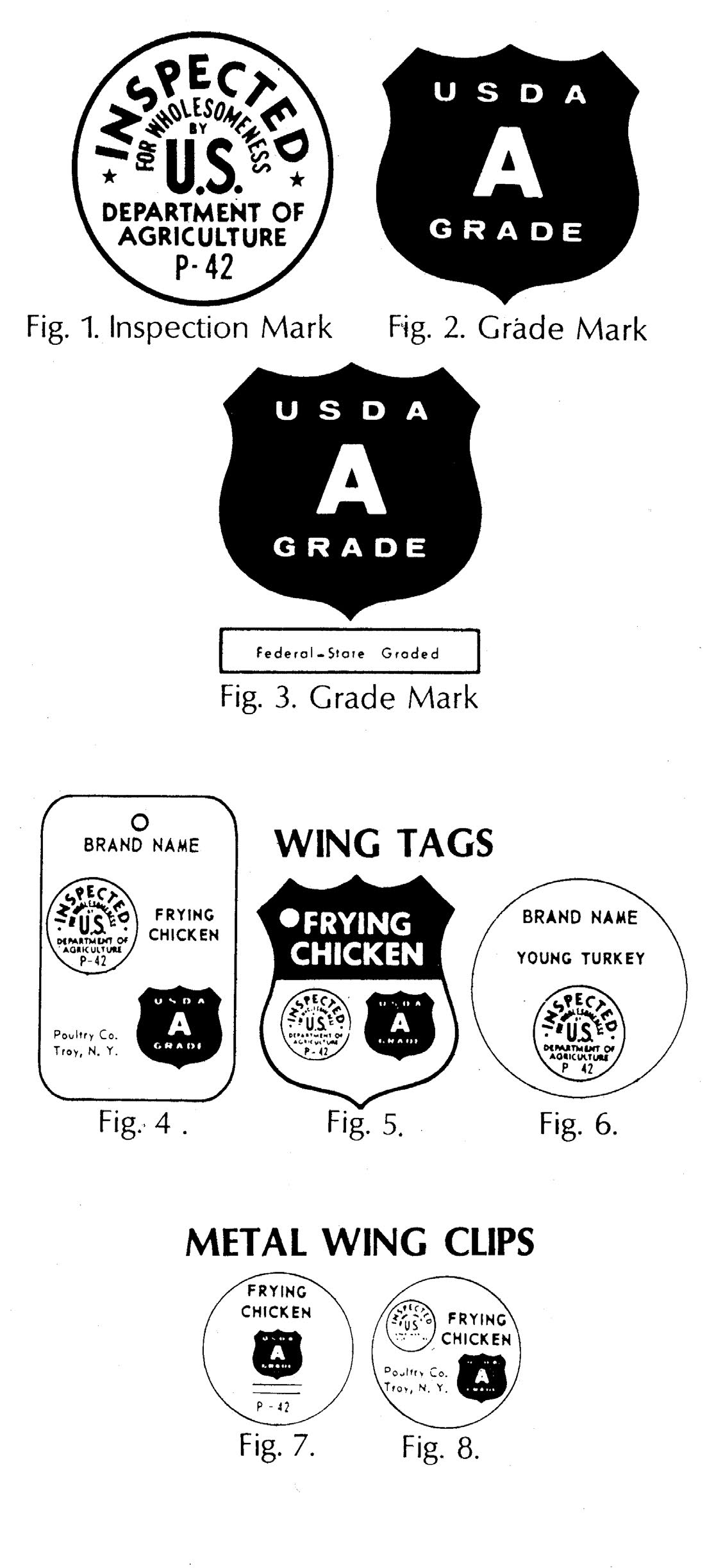
- Dirty – The shell must be unbroken with adhering dirt or foreign material, or having prominent stains covering more than 1/32 of the shell surface if localized or 1/16 of shell if scattered. The illustrations are intended as guides and are not to be used as an actual measurement in grading. Graders should learn to determine the area that constitutes these measurements and then judge eggs having soiled shells against this mental picture.
- Shell color – Shell color does not affect the quality of the egg, so it is not considered in the U.S. standards of quality or grades.
Class 4 – What Consumers Need to Know About Eggs and Ready-to-Cook Poultry
Eggs are sold by weight and grade. The egg carton must be marked with the grade and weight. For example, GRADE A LARGE, GRADE A MEDIUM, or GRADE A SMALL. In Mississippi, eggs may be sold as unclassified, and the carton must be marked as ONE DOZEN EGGS, UNCLASSIFIED. The different grades and sizes may be in the dozen unclassified eggs.
The three consumer grades are U.S. Grade AA (or Fresh Fancy), Grade A, and Grade B. U.S. Grade AA and Fresh Fancy are the same grade. Egg prices vary by size for the same grade. The amount of price variation depends on the supply of the various sizes.
Generally speaking, the spread in price between sizes should be 10 cents per dozen. If Grade A Large sell for 80 cents per dozen, then Grade A Medium should sell for 70 cents per dozen. If there is less than a 10-cent price spread per dozen between one size and the next smaller size in the same grade, you will get more for your money by buying the larger size.
Shell color is determined by the breed of the hen and does not affect the grade, nutritive value, flavor, or cooking performance of the egg. Temperature and age are the egg’s greatest enemies. Eggs should be stored at 50 °F as soon as laid and remain at this temperature until ready to cook.
The official circular inspection mark is required on poultry that is inspected under the mandatory inspection program (Figure 1). The grade mark must be one of the forms and designs illustrated in Figures 2 and 3, and must be printed with light-colored letters on a dark field.
Wing tags and metal clips or other labels that bear either the inspection mark or grade mark or both must also show either the plant number or the firm name and address (Figures 7 and 8).
The kind (such as chicken, turkey, or duck) without the qualifying term “young” or “mature” or “old,” or class name is not permitted. Figures 4, 5, and 6 are examples of satisfactory wing tags. When both marks are shown on a tag, they must both appear on the same side of the tag. Both marks may appear on each side of the tag.
Figure 6 does not show a grade mark. It does show the kind (“young turkey”) and the circular inspection mark. The grade mark is not required in this case because the bird is not graded.
Publication 900 (POD-12-19)
Distributed by Tom Tabler, PhD, Extension Professor, Poultry Science. Written by Tom W. Smith Jr., PhD, former Extension Poultry Specialist.
Copyright 2019 by Mississippi State University. All rights reserved. This publication may be copied and distributed without alteration for nonprofit educational purposes provided that credit is given to the Mississippi State University Extension Service.
Produced by Agricultural Communications.
Mississippi State University is an equal opportunity institution. Discrimination in university employment, programs, or activities based on race, color, ethnicity, sex, pregnancy, religion, national origin, disability, age, sexual orientation, genetic information, status as a U.S. veteran, or any other status protected by applicable law is prohibited. Questions about equal opportunity programs or compliance should be directed to the Office of Compliance and Integrity, 56 Morgan Avenue, P.O. 6044, Mississippi State, MS 39762, (662) 325-5839.
Extension Service of Mississippi State University, cooperating with U.S. Department of Agriculture. Published in furtherance of Acts of Congress, May 8 and June 30, 1914. GARY B. JACKSON, Director
The Mississippi State University Extension Service is working to ensure all web content is accessible to all users. If you need assistance accessing any of our content, please email the webteam or call 662-325-2262.




